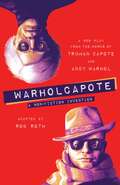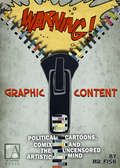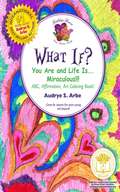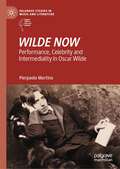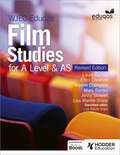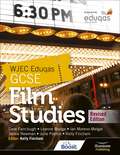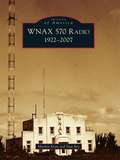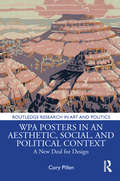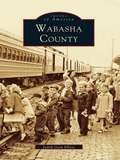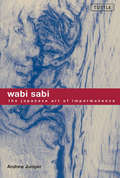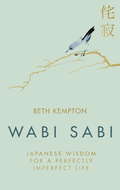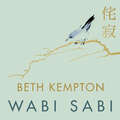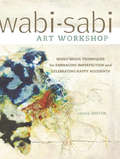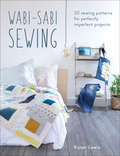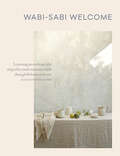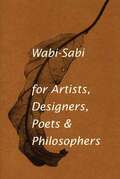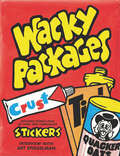- Table View
- List View
WARHOLCAPOTE: A Non-Fiction Invention
by Rob RothAn enthralling play based on lost tapes between two cultural giants and friends—Andy Warhol and Truman Capote.In 1978 Andy Warhol and Truman Capote decided to write a Broadway play. Andy suggested that he record their private conversations over the period of a few months, and that these tapes would be the source material for the play. The tapes were then filed away and forgotten. Their play was never completed. Now, award-winning director Rob Roth brings their vision to life after a years-long search to unearth the eighty hours of tapes between two of the most daring artists of postwar America. WARHOLCAPOTE, based on words actually spoken by the two men, is set in the &’70s and &’80s, toward the end of their close connection and not too long before their untimely deaths. Their special, complex friendship is captured by Roth with bracing intimacy as they discuss life, love, and art and everything in between. Every word in the play comes directly from these two 20th century geniuses. The structure of the conversations springs from Roth&’s imagination.
WARNING! Graphic Content: Political Cartoons, Comix and the Uncensored Artistic Mind
by Larry Gross Mr FishHave your IDs ready and your intolerance for incendiary pictures and controversial ideas checked at the door for it's time to step into the head of the unabashedly liberal, award-winning cartoonist and writer Dwayne Booth (aka "Mr. Fish"), where inflammatory ideas meet deep insights and something like inspiring woe, discouraging indifference and gleeful nihilism are born!In this new book, WARNING! Graphic Content,Mr. Fish examines the past, present and future of art as commentary, deciphering its substructure and translating its unique alphabet into a wholly accessible vocabulary. Through extensive interviews, numerous audio and video clips and nearly 400 provocative images, he demonstrates unequivocally how uncensored art and weaponized jokes from cartoonists, satirists and fine artists through history provide humanity with its most thorough and revealing self-portraits. Find out what is right and wrong with the profession of political cartooning. Discover the truth about why our visual language is so much more adept than our verbal language at explaining and understanding the existential stuff and nonsense that elates and burdens us every day. Have you ever wondered: What's the difference between art and craft? Why are artists so poorly paid? If Yoko Ono sat silently in the middle of a crowded auditorium in her underpants and everybody was there to see it, would she make any sense whatsoever? What is a bogey ball and does it really need to be made out of real snot to be impactful? Mr. Fish answers all these questions and more in this book! This is work that provokes thought and debate and great peels of laughter, but is not intended for the faint of heart.
WHAT IF?: You Are and Life Is Miraculous! ABC, Affirmation, Art Coloring Book
by Audrye S. ArbeWHAT IF? YOU ARE AND LIFE IS MIRACULOUS!, ABC, Affirmation, Art Coloring Book, printed on 100 percent post-consumer recycled paper, is ready for you! Great for anyone five years young and beyond, this book transforms and uplifts the reader's vibration, intrigues and piques the intellect with outstanding words, plus leads to brain-enhancement with its multi-perspective Audrye OmArt: Art That Opens the Heart (c). Coloring is the new meditation, hailed by psychologists as a way to uplift depression, help those in recovery, and, this book in particular, bring forth gales of laughter. Children, adolescents, teens, and adults love this book! Each run benefits the planet, as well, as testified to by www.GreenPressInitiative.org in the book itself.
WILDE NOW: Performance, Celebrity and Intermediality in Oscar Wilde (Palgrave Studies in Music and Literature)
by Pierpaolo MartinoWILDE NOWreads Oscar Wilde through our now, through a contemporary sensibility (and approach), in which literature and popular culture interrogate and are interrogated by critical concepts and categories such as performance, celebrity, intermediality, and consumerism. This volume exceeds the shape and meaning of a critical study to turn into a drama of five different acts/moments in Wilde’s life and work: his early performances in Dublin, London and Oxford; the 1882 American tour; his successful season of the first half of the 1890s, his prison years and finally his glorious resurrection in contemporary pop culture. Most importantly WILDE NOW approaches these moments through contemporary rewritings and performances of “Oscar Wilde” in the fields of cinema, music and literature by such artists as Al Pacino, Rupert Everett, Stephen Fry, Gyles Brandreth, David Hare, David Bowie, Morrissey, Nick Cave, Neil Tennant, Gavin Friday. These artists – through their awareness of the importance of being/playing Oscar in their specific worlds and cultural contexts – will also show us that Wilde can be conceived as a subversive, critical role one might successfully perform and appropriate, now more than ever.
WJEC Eduqas Film Studies for A Level & AS – Student Book - Revised Edition
by Mark Ramey Ellen Cheshire Jenny Stewart Lisa Wardle Laura Barbey Maxine CramptonWritten by experienced Film Studies authors and teachers, this Student Book provides the core knowledge and exemplification you will need throughout your Film Studies course and will help to prepare you thoroughly for your exams.- Concepts are explored through in-depth case study chapters on 14 films from the specification including: Casablanca, Bonnie and Clyde, La La Land, Beasts of the Southern Wild, Trainspotting, Sightseers, Mustang, Taxi Tehran, Stories We Tell, Sunrise, Buster Keaton shorts, Pulp Fiction, Daisies and Saute ma Ville, as well as references to many other films- A dedicated chapter on the Non-Examined Assessment production element of the specification provides practical tips on film production- Independent Activities provide direction and suggestions for study outside the classroom to broaden knowledge of the genres under study- Study Tips give advice on skills and highlight best practice when revising for your exams- Key Definitions introduce and reinforce key terminology and examples of how they should be used are provided- Exam-style questions enable you to test yourself and help you refine your exam technique- Sample extracts from student essays with expert commentaries help you to improve your exam technique
WJEC Eduqas Film Studies for A Level & AS – Student Book - Revised Edition
by Mark Ramey Ellen Cheshire Jenny Stewart Lisa Wardle Laura Barbey Maxine CramptonWritten by experienced Film Studies authors and teachers, this Student Book provides the core knowledge and exemplification you will need throughout your Film Studies course and will help to prepare you thoroughly for your exams.- Concepts are explored through in-depth case study chapters on 14 films from the specification including: Casablanca, Bonnie and Clyde, La La Land, Beasts of the Southern Wild, Trainspotting, Sightseers, Mustang, Taxi Tehran, Stories We Tell, Sunrise, Buster Keaton shorts, Pulp Fiction, Daisies and Saute ma Ville, as well as references to many other films- A dedicated chapter on the Non-Examined Assessment production element of the specification provides practical tips on film production- Independent Activities provide direction and suggestions for study outside the classroom to broaden knowledge of the genres under study- Study Tips give advice on skills and highlight best practice when revising for your exams- Key Definitions introduce and reinforce key terminology and examples of how they should be used are provided- Exam-style questions enable you to test yourself and help you refine your exam technique- Sample extracts from student essays with expert commentaries help you to improve your exam technique
WJEC Eduqas GCSE (9-1) Design and Technology
by Chris Walker Ian Fawcett Dan Hughes Andy Knight Jennifer Tilley Jacqui HowellsExam board: WJEC EduqasLevel: GCSESubject: Design & TechnologyFirst teaching: September 2017First exams: Summer 2019Reinforce classroom learning and boost students' understanding of all materials with this textbook written for the WJEC Eduqas GCSE (9-1) Design & Technology specification.Written by leading D&T experts, this textbook will build your students' knowledge of the core principles, help to develop their designing and making skills and provide them with the opportunity to make sure they are ready to tackle both parts of the assessment. - Helps students clearly understand the core principles of all materials and general concepts of designing and making, as well as build their knowledge, understanding and skills for one material or system in more depth- Hones students' mathematical and scientific ability so they don't miss out on the easy marks- Features practice questions in the style of the written exam to make sure students are confident to tackle the written element of the assessment- Inspires and motivates students with stretch and challenge: activities designed to challenge the more able learners and to ensure progression to A-level
WJEC Eduqas GCSE Film Studies – Student Book - Revised Edition
by Jackie Newman Dave Fairclough Kelly Fincham Julie Patrick Ian Moreno-Melgar Leanne MadgeRevised and updated to match the latest WJEC Eduqas GCSE Film Studies specification and covering many of the latest film texts for assessment from 2024, this highly visual and engaging Student Book will support students through the course and help prepare them for their exams.- Written by a team of experienced examiners and teachers, this book offers high quality support you can trust.- Comprehensive definitions of key terms throughout the book with examples of how they should be used in analyses.- Case studies of key films provide an in-depth exploration of the key elements of film form.- A dedicated chapter on the Non-Examined Assessment production element of the specification provides clear guidance on how students will be assessed.- New stretch and challenge tasks allow students to further develop their understanding.- Exam-style questions enable students to test themselves and help refine exam technique.- Sample exam questions with student answers and teacher commentaries show how to produce high-mark answers and prepare for the exam.
WJEC GCSE Design and Technology
by Chris Walker Ian Fawcett Dan Hughes Andy Knight Jennifer Tilley Jacqui HowellsExam board: WJECLevel: GCSESubject: Design and TechnologyFirst teaching: September 2017First exams: Summer 2019Reinforce classroom learning and boost students' understanding of their chosen area of design and technology with this textbook written for the WJEC GCSE Design & Technology specification for Wales.Written by leading D&T experts, this textbook will build your students' knowledge of the core principles, help to develop their designing and making skills and provide them with the opportunity to make sure they are ready to tackle both parts of the assessment. - Helps students clearly understand the core knowledge, understanding and skills and general concepts of designing and making, as well as build their knowledge, understanding and skills of either Engineering Design, Fashion and Textiles or Product Design in more depth- Hones students' mathematical and scientific ability so they don't miss out on the easy marks- Features practice questions in the style of the written exam to make sure students are confident to tackle the written element of the assessment- Inspires and motivates students with stretch and challenge: activities designed to challenge the more able learners and to ensure progression to A-level
WNAX 570 Radio: 1922-2007
by Stan Ray Marilyn KratzLife on the northern plains was lonely in the early 20th century. Farmers and ranchers went for weeks without hearing any voices other than those of their families. Then, in 1922, Al Madson, proprietor of a Yankton radio parts shop, made a radio transmitter. He formed a broadcasting company, and on November 25, 1922, WNAX broadcast its first program. People of the northern plains now had a daily "visitor." Gurney Seed and Nursery Company owned the station for its first 16 years, adding distinctive innovations to its programming. In its constant commitment to agriculture, the station has influenced the history of the five-state area it covers. Lawrence Welk got his start there. Wynn Speece, known as the Neighbor Lady, still broadcasts daily after starting at WNAX in 1941.
WPA Posters in an Aesthetic, Social, and Political Context: A New Deal for Design (Routledge Research in Art and Politics)
by Cory PillenThis book examines posters produced by the Works Progress Administration (WPA), a federal relief program designed to create jobs in the United States during the Great Depression. Cory Pillen focuses on several issues addressed repeatedly in the roughly 2,200 extant WPA posters created between 1935 and 1943: recreation and leisure, conservation, health and disease, and public housing. As the book shows, the posters promote specific forms of knowledge and literacy as solutions to contemporary social concerns. The varied issues these works engage and the ideals they endorse, however, would have resonated in complex ways with the posters’ diverse viewing public, working both for and against the rhetoric of consensus employed by New Deal agencies in defining and managing the relationship between self and society in modern America. This book will be of interest to scholars in design history, art history, and American studies.
WTF, Evolution?!: A Theory of Unintelligible Design
by Mara GrunbaumWe all have our off days. Why should Evolution be any different? Maybe Evolution got carried away with an idea that was just a little too crazy—like having the Regal Horned Lizard defend itself by shooting three-foot streams of blood from its eyes. Or maybe Evolution ran out of steam (Memo to Evolution: The Irrawaddy Dolphin looks like a prototype that should have been left on the drawing board). Or maybe Evolution was feeling cheeky—a fish with hands? Joke’s on you, Red Handfish! Or maybe Evolution simply goofed up: How else to explain the overgrown teeth of the babirusas that curl backward over their face? Oops. Mara Grunbaum is a very smart, very funny science writer who celebrates the best—or, really, the worst—of Evolution’s blunders. Here are more than 100 outlandish mammals, reptiles, insects, fish, birds, and other creatures whose very existence leaves us shaking our heads and muttering WTF?! Ms. Grunbaum’s especially brilliant stroke is to personify Evolution as a well-meaning but somewhat oblivious experimenter whose conversations with a skeptical narrator are hilarious. For almost 4 billion years, Evolution has produced a nonstop parade of inflatable noses, bizarre genitalia, and seriously awkward necks. What a comedian!
WYXIE Wonderland: An Unauthorized 50-Year Diary of WXYZ Detroit
by Dick OsgoodWYXIE WONDERLAND, by Dick Osgood, is a good time and more than that. Here is possibly the first comprehensive exploration into the inner workings of a broadcasting enterprise. It is as broad as it is deep, revealing the secrets of top management as completely as--perhaps even more fully than--it does the vagaries of performing talent. It is not a purely local story. Fifty years of national radio and television history--1925-1975--are reflected in the fundamental and accidental specifics of a single station--WXYZ, Detroit-AM, FM and TV. This is the diary of that station, unauthorized and independently written. WYXIE WONDERLAND was much more than the birthplace of The Lone Ranger, The Green Hornet and Sergeant Preston of the Yukon. It was the starting point of SOUPY SALES and MIKE WALLACE, of DOUGLAS EDWARDS and JOHN HODIAK, of GEORGE SEATON, MARTHA SCOTT and DANNY THOMAS. Here are the hilarious fluffs, minor on-the-air disasters and a phantom broadcast. This extraordinary book traces the beginnings of five networks; it follows the rise and decline of radio network programming. It sees the radio actor replaced by--the disc jockey. There are record hops with FABIAN, CHUCK BERRY and STEVIE WONDER. WYXIE WONDERLAND explains how the scandal of radio payola grew out of the discovery of rigged TV quiz programs. It tells of a sound created in Texas that revolutionized radio, and how the Top 40 format emerged from a bar in Omaha. The confusion of early television is in it as well as of early radio, and the nefarious underground beginnings of FM. Alcoholism is discovered to be something of an occupational disease. The infighting among stations and executives for ratings, accounts and position gets tough. Personalities clash. There are victories and surprising defeats.
Wabasha County
by Judith Giem ElliotWabasha County captures the spirit of a region and its people through rare historic photographs, many of which are previously unpublished. A truly multicultural community, Wabasha County has been home to residents of Canadian, French, English, Irish, Native American, and German origin. The earliest known pioneers, Augustine Rocque and his family, became the first white people to occupy a year-round residence in Minnesota in 1826. Within these pages, discover the people and events that have shaped Wabasha County's history over the past 170 years. Wabasha County was named after the great chief Wabashaw II. Many aspects of Wabasha's heritage are featured here, including the dewakanton Band of the Dakotas, riverboats of the Mississippi, pioneers and their descendants, and buildings throughout the area. Author Judith Giem Elliott has produced a volume that truly reflects the value Wabasha County's residents place upon their rich and colorful history.
Wabi Sabi
by Andrew JuniperWabi sabi, the quintessential Japanese design aesthetic, is quickly gaining popularity around the world, as evidenced by recent articles in Time, The Chicago Tribune and Kyoto Journal. Taken from the Japanese words wabi, which translates to less is more, and sabi, which means attentive melancholy, wabi sabi refers to an awareness of the transient nature of earthly things and a corresponding pleasure in the things that bear the mark of this impermanence. As a design style, wabi sabi helps us to appreciate the simple beauty in imperfection--of a chipped vase or a rainy day, for example.
Wabi Sabi
by Andrew JuniperWabi sabi, the quintessential Japanese design aesthetic, is quickly gaining popularity around the world, as evidenced by recent articles in Time, The Chicago Tribune and Kyoto Journal. Taken from the Japanese words wabi, which translates to less is more, and sabi, which means attentive melancholy, wabi sabi refers to an awareness of the transient nature of earthly things and a corresponding pleasure in the things that bear the mark of this impermanence. As a design style, wabi sabi helps us to appreciate the simple beauty in imperfection--of a chipped vase or a rainy day, for example.
Wabi Sabi
by Andrew JuniperDeveloped out of the aesthetic philosophy of cha-no-yu (the tea ceremony) in fifteenth-century Japan, wabi sabi is an aesthetic that finds beauty in things imperfect, impermanent, and incomplete. Taken from the Japanese words wabi, which translates to less is more, and sabi, which means attentive melancholy, wabi sabi refers to an awareness of the transient nature of earthly things and a corresponding pleasure in the things that bear the mark of this impermanence. As much a state of mind--an awareness of the things around us and an acceptance of our surroundings--as it is a design style, wabi sabi begs us to appreciate the simple beauty in life--a chipped vase, a quiet rainy day, the impermanence of all things. Presenting itself as an alternative to today's fast-paced, mass-produced, neon-lighted world, wabi sabi reminds us to slow down and take comfort in the simple, natural beauty around us.In addition to presenting the philosophy of wabi-sabi, this book includes how-to design advice--so that a transformation of body, mind, and home can emerge.Chapters include:History: The Development of Wabi SabiCulture: Wabi Sabi and the Japanese CharacterArt: Defining AestheticsDesign: Creating Expressions with Wabi Sabi MaterialsSpirit: The Universal Spirit of Wabi Sabi
Wabi Sabi Painting with Cold Wax: Adding Body, Texture and Transparency to Your Art
by Serena BartonThe ancient philosophy of wabi-sabi honors the imperfect, the transitory and the humble. Cold wax is a perfect vehicle for artists wishing to explore this aesthetic. In this guide, you'll learn how to use this incredibly malleable medium--in combination with oil paint and other mediums--to add layers of texture, atmosphere, depth and meaning to your paintings while developing a more intuitive artistic voice.No matter what your experience level, learning to paint with cold wax will help you approach your work with confidence and a sense of adventure. You will learn a liberating process of texturing, layering, building up and scraping back to create a fascinating "history of surface." Each piece will be the result of elements converging in a one-time-only way, resulting in fiercely original abstract paintings honoring your own process of self discovery.Learn Everything You Need to Know to Create With Cold Wax!29 step-by-step demonstrations cover various techniques for working with oil paint and cold wax medium.Explore dozens of mark-making techniques with a variety of tools, most of which can be found in your kitchen or junk drawer.Excavate using various approaches for incising, exposing and scraping away layers.Get inspired as 12 additional artists share their creative processes. Embrace unexpected turns, discover the beauty in simplicity and lose yourself in the process as you join Serena Barton on this creative and spiritual journey.
Wabi Sabi: Japanese Wisdom for a Perfectly Imperfect Life
by Beth Kempton'A truly transformative read' Sunday Times STYLE'More than ever, we need books like this' Jessica Seaton, Co-Founder of Toast and author of Gather, Cook, FeastA whole new way of looking at the world - and your life - inspired by centuries-old Japanese wisdom.Wabi sabi ("wah-bi sah-bi") is a captivating concept from Japanese aesthetics, which helps us to see beauty in imperfection, appreciate simplicity and accept the transient nature of all things. With roots in zen and the way of tea, the timeless wisdom of wabi sabi is more relevant than ever for modern life, as we search for new ways to approach life's challenges and seek meaning beyond materialism.Wabi sabi is a refreshing antidote to our fast-paced, consumption-driven world, which will encourage you to slow down, reconnect with nature, and be gentler on yourself. It will help you simplify everything, and concentrate on what really matters.From honouring the rhythm of the seasons to creating a welcoming home, from reframing failure to ageing with grace, wabi sabi will teach you to find more joy and inspiration throughout your perfectly imperfect life.This book is the definitive guide to applying the principles of wabi sabi to transform every area of your life, and finding happiness right where you are.
Wabi Sabi: Japanese Wisdom for a Perfectly Imperfect Life
by Beth Kempton'A truly transformative read' Sunday Times STYLE'More than ever, we need books like this' Jessica Seaton, Co-Founder of Toast and author of Gather, Cook, FeastA whole new way of looking at the world - and your life - inspired by centuries-old Japanese wisdom.Wabi sabi ("wah-bi sah-bi") is a captivating concept from Japanese aesthetics, which helps us to see beauty in imperfection, appreciate simplicity and accept the transient nature of all things. With roots in zen and the way of tea, the timeless wisdom of wabi sabi is more relevant than ever for modern life, as we search for new ways to approach life's challenges and seek meaning beyond materialism.Wabi sabi is a refreshing antidote to our fast-paced, consumption-driven world, which will encourage you to slow down, reconnect with nature, and be gentler on yourself. It will help you simplify everything, and concentrate on what really matters.From honouring the rhythm of the seasons to creating a welcoming home, from reframing failure to ageing with grace, wabi sabi will teach you to find more joy and inspiration throughout your perfectly imperfect life.This book is the definitive guide to applying the principles of wabi sabi to transform every area of your life, and finding happiness right where you are.
Wabi-Sabi Art Workshop: Art Workshop
by Serena BartonAre you inspired by the little things, the bits others might overlook? A crack in the sidewalk? The trunk of a fallen tree? Shards of broken pottery? Do you want your artwork to speak to the abstract nature of color, and shape and texture, composition and mood? With Wabi-Sabi Art Workshop, you'll learn to use your appreciation for the simple things in life--the ordinary, the aged, the humble--as your inspiration for making expressive, intuitive art. You will come to embrace imperfection and recognize that, yes, in fact, there is such a thing as a happy accident! The wabi-sabi philosophy of art is probably a little different from what you're used to--it's a style that finds inspiration and beauty in the imperfect, impermanent and humble nature of everyday objects. And there is a special freedom in wabi-sabi's abstract aesthetic, a forgiving approach that celebrates so-called mistakes and fosters an experimental spirit, encouraging you to build up and tear back with abandon. Inside Wabi-Sabi Art Workshop You'll Find: Dozens of inspiration photos and tips for taking your own. 27 traditional haikus. 35 techniques using such diverse media as oil and acrylic paints, alcohol inkers, foils and leaf, pastels, plaster, collage and handmade papers, teabags, paper towels, coffee, crayons, encaustic paints, fibers and more. Lots of Wabi-Sabi Wisdom--tips and troubleshooting. 70 big, beautiful finished pieces of art illustrating featured techniques. Links to online bonus content--step-by-step demonstrations illustrating six additional techniques. Add Wabi-Sabi Art Workshop to your artistic library and expand your artistic horizons today!
Wabi-Sabi Sewing: 20 Sewing Patterns for Perfectly Imperfect Projects
by Karen LewisCapture the essence of Japanese style in your sewing with this collection of projects inspired by the wabi-sabi concept of 'perfect imperfection'. This collection of 20 sewing projects for home decor and accessories is based on the popular Japanese aesthetic of wabi-sabi which celebrates the beauty in the ordinary and imperfect. The projects are grouped according to how we live, for example: living; sleeping; eating and exploring. Sewing and quilting expert and fabric designer, Karen Lewis, has used a limited palette of earthy tones and the best quality natural fabrics including linen, cotton, denim and wool to create a stunning collection of simple, sewn projects. Try out some simple wabi-sabi style sewing techniques such as hand hand piecing, sashiko embroidery, big stitch quilting, and visible mending to create unique items for your home whether it's a full sized bed quilt, simple coasters for your favourite mug or a stunning scarf to wrap up in.
Wabi-Sabi Welcome: Learning to Embrace the Imperfect and Entertain with Thoughtfulness and Ease
by Julie Pointer Adams“An antidote to the veneer of perfectionism so often presented by books of its kind, Wabi-Sabi Welcome offers readers license to slow down and host guests with humility, intention, and contentment.” —Nathan Williams, founder of KinfolkWabi-Sabi Welcome is sharing a pot of tea with friends. It is preparing delicious food to nourish, not to show off. It’s keeping a basket of cozy slippers at the door for guests. It is well-worn linens, bouquets of foraged branches, mismatched silverware, and heirloom bowls infused with the spirit of meals served with love. In this lush entertaining manual, author Julie Pointer Adams invites readers into artful, easygoing homes around the world—in Denmark, California, France, Italy, and Japan—and teaches us how to turn the generous act of getting together into the deeper art of being together. In this book, readers will find: unexpected, thoughtful ideas and recipes from around the world; tips for creating an intimate, welcoming environment; guidelines for choosing enduring, natural decor for the home; and inspiring photographs from homes where wabi-sabi is woven into daily living.
Wabi-Sabi for Artists, Designers, Poets & Philosophers
by Leonard KorenEvery book with "wabi" or "wabi sabi" in the title is based on the concepts first elucidated in this book.
Wacky Packages (Topps Ser.)
by The Topps CompanyTake a fun look back at Quacker Oats, Blisterine, and more classic packaging parodies—plus an interview with creator Art Spiegelman! Known affectionately among collectors as &“Wacky Packs,&” the Topps stickers that parodied well-known consumer brands were a phenomenon in the 1970s—even outselling the Topps Company&’s baseball cards for a while. But few know that the genius behind it all was none other than Art Spiegelman—the Pulitzer Prize–winning graphic novelist who created Maus. This treasury includes an interview with Spiegelman about his early career and his decades-long relationship with the memorabilia company—as well as a colorful compendium that will bring back memories of such products as Plastered Peanuts, Jail-O, Weakies cereal, and many more. Illustrated by notable comics artists Kim Deitch, Bill Griffith, Jay Lynch, Norm Saunders, and more, this collection is a visual treat, a load of laughs, and a tribute to a beloved product that&’s been delighting kids (and adults) for decades.
